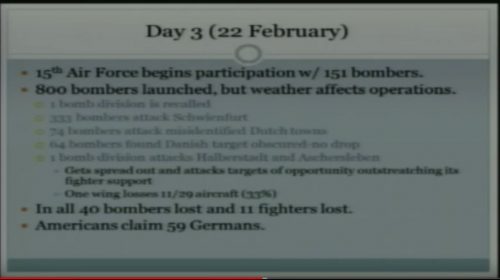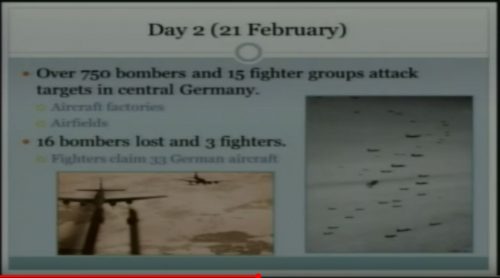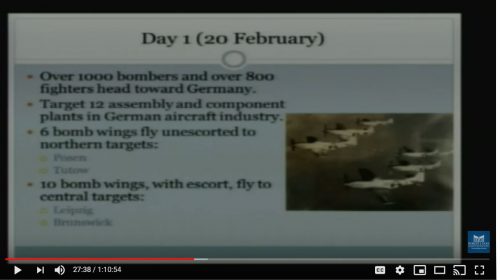Today marks the 75th Anniversary of the third day of Operation Argument otherwise known as BIG WEEK. On Tuesday, February 22, 1944 the 15th Air Force went after the Luftwaffe in the skies over Germany — with the 8th Air Force operations being heavily disrupted by fog — in the battle for air superiority before the Normandy invasion scheduled for June 1944.
The idea for Operation Argument was to force the Luftwaffe fighter force to fight by attacking targets they had to defend — the German aircraft industry — with fighter escorted bombers.
The 15th Air Force attacked without fighter escorts.
Oops.
These were the results of the 3rd day of combat —

ETO Strategic Operations
Mission 230: “Big Week” continues with 799 aircraft dispatched against German aviation and Luftwaffe airfields; 41 bombers and 11 fighters are lost.
- 289 B-17s are dispatched against aviation industry targets at Aschersleben (34 bomb), Bernburg (47 bomb) and Halberstadt (18 bomb) in conjunction with a Fifteenth Air Force raid on Regensburg, Germany; 32 hit Bünde, 19 hit Wernigerode, 15 hit Magdeburg, 9 hit Marburg and 7 hit other targets of opportunity; they claim 32-18-17 Luftwaffe aircraft; 38 B-17s are lost, 4 damaged beyond repair and 141 damaged; casualties are 35 KIA, 30 WIA and 367 MIA.
- 333 B-17s are dispatched to Schweinfurt but severe weather prevents aircraft from forming properly and they are forced to abandon the mission prior to crossing the enemy coast; 2 B-17s are damaged.
- 177 B-24s are dispatched but they are recalled when 100 miles (160 km) inland; since they were over Germany, they sought targets of opportunity but strong winds drove the bombers over The Netherlands and their bombs hit Enschede, Arnhem, Nijmegen and Deventer; they claim 2-0-0 Luftwaffe aircraft; 3 B-24s are lost and 3 damaged; casualties are 30 MIA. About 900 civilians were killed, mainly in the bombing of Nijmegen. In 1984, the book De Fatale Aanval (“The Fatal Attack”), was written about this by eyewitness Alphons Brinkhuis, who was a 10-year-old boy at Enschede when it happened.
These missions are escorted by 67 P-38s, 535 Eighth and Ninth Air Force P-47s, and 57 Eighth and Ninth Air Force P-51s; the P-38s claim 1 Luftwaffe aircraft destroyed, 1 P-38 is damaged beyond repair and 6 are damaged; the P-47s claim 39-6-15[clarification needed] Luftwaffe aircraft, 8 P-47s are lost and 12 damaged, 8 pilots are MIA; the P-51s claim 19-1-10 Luftwaffe aircraft, 3 P-51s are lost and 3 damaged, 3 pilots are MIA.
MTO Strategic Operations
B-17s attack Petershausen marshaling yard and Regensburg aircraft factory in Germany and the air depot at Zagreb, Yugoslavia; a large force of B-24s hits Regensburg aircraft plants about the same time as the B-17 attack; other B-24s pound the town of Sibenik and the harbor at Zara, Yugoslavia; they claim 40 Luftwaffe aircraft destroyed; 13 bombers are lost.
For extensive background, see this Wikipedia article, where the passage above came from:
https://en.wikipedia.org/wiki/Big_Week
Exposing the Bomber General Lies in the “P-51 Narrative”
For all the good that the P-47 Thunderbolt did in Europe’s strategic bombing offensive, it has been written out of the victory narrative for a lot of political reasons. Political reasons starting with answering for the 26,000 men who died in the 8th Air Force in WW2 because of the flawed doctrines of the the USAAF Bomber Generals. A number of combat deaths that is larger than the entire US Marine Corps in World War 2 from Pearl Harbor to Hiroshima.
I’ve written expansively on how these flawed doctrines affected the development of auxiliary drop tank technology, the escort fighters that used them and the bomber escort doctrine that knit them together over the years on Chicagoboyz, See these posts:
History Friday — MacArthur’s Fighter Drop Tanks
Posted by Trent Telenko on July 12th, 2013
https://chicagoboyz.net/archives/37362.html
History Friday: Deconstructing the P-51 Mustang Historical Narrative
Posted by Trent Telenko on September 27th, 2013
https://chicagoboyz.net/archives/38801.html
History Friday — Revisiting the P-51 Mustang Historical Narrative
Posted by Trent Telenko on December 16th, 2016
https://chicagoboyz.net/archives/54434.html
Right now I’m going to show you how Generals Arnold, Spaatz, Anderson and the rest of the “Bomber General Mafia” put the bad mouth on the P-47’s role in obtaining air superiority over Europe.

